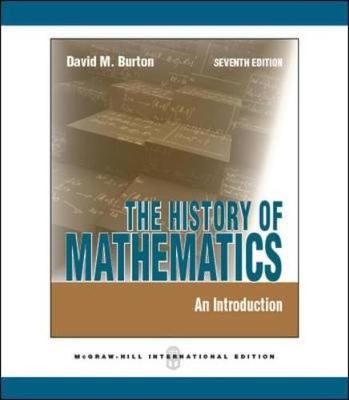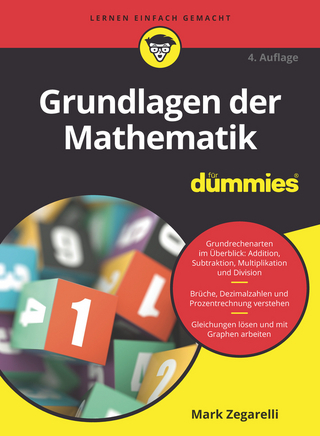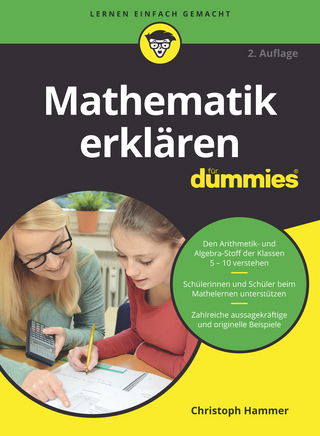
The History of Mathematics: An Introduction (Int'l Ed)
McGraw Hill Higher Education (Verlag)
978-0-07-128920-7 (ISBN)
- Titel ist leider vergriffen;
keine Neuauflage - Artikel merken
The History of Mathematics: An Introduction, Seventh Edition, is written for the one- or two-semester math history course taken by juniors or seniors, and covers the history behind the topics typically covered in an undergraduate math curriculum or in elementary schools or high schools. Elegantly written in David Burton’s inimitable prose, this classic text provides rich historical context to the mathematics that undergrad math and math education majors encounter every day. Burton illuminates the people, stories, and social context behind mathematics’ greatest historical advances while maintaining appropriate focus on the mathematical concepts themselves. Its wealth of information, mathematical and historical accuracy, and renowned presentation make The History of Mathematics: An Introduction, Seventh Edition a valuable resource that teachers and students will want as part of a permanent library.
The History of Mathematics: An Introduction, 7e by David M. Burton Preface 1Early Number Systems and Symbols 1.1 Primitive Counting A Sense of Number Notches as Tally Marks The Peruvian Quipus: Knots as Numbers 1.2 Number Recording of the Egyptians and Greeks The History of Herodotus Hieroglyphic Representation of Numbers Egyptian Hieratic Numeration The Greek Alphabetic Numeral System 1.3 Number Recording of the Babylonians Babylonian Cuneiform Script Deciphering Cuneiform: Grotefend and Rawlinson The Babylonian Positional Number System Writing in Ancient China 2 Mathematics in Early Civilizations 2.1 The Rhind Papyrus Egyptian Mathematical Papyri A Key to Deciphering: The Rosetta Stone 2.2 Egyptian Arithmetic Early Egyptian Multiplication The Unit Fraction Table Representing Rational Numbers 2.3 Four Problems from the Rhind Papyrus The Method of False Position A Curious Problem Egyptian Mathematics as Applied Arithmetic 2.4 Egyptian Geometry Approximating the Area of a Circle The Volume of a Truncated Pyramid Speculations About the Great Pyramid 2.5 Babylonian Mathematics A Tablet of Reciprocals The Babylonian Treatment of Quadratic Equations Two Characteristic Babylonian Problems 2.6 Plimpton A Tablet Concerning Number Triples Babylonian Use of the Pythagorean Theorem The Cairo Mathematical Papyrus 3 The Beginnings of Greek Mathematics 3.1 The Geometric Discoveries of Thales Greece and the Aegean Area The Dawn of Demonstrative Geometry: Thales of Miletos Measurements Using Geometry 3.2 Pythagorean Mathematics Pythagoras and His Followers Nichomachus' Introductio Arithmeticae The Theory of Figurative Numbers Zeno's Paradox 3.3 The Pythagorean Problem Geometric Proofs of the Pythagorean Theorem Early Solutions of the Pythagorean Equation The Crisis of Incommensurable Quantities Theon's Side and Diagonal Numbers Eudoxus of Cnidos 3.4 Three Construction Problems of Antiquity Hippocrates and the Quadrature of the Circle The Duplication of the Cube The Trisection of an Angle 3.5 The Quadratrix of Hippias Rise of the Sophists Hippias of Elis The Grove of Academia: Plato's Academy 4 The Alexandrian School: Euclid 4.1 Euclid and the Elements A Center of Learning: The Museum Euclid's Life and Writings 4.2 Euclidean Geometry Euclid's Foundation for Geometry Book I of the Elements Euclid's Proof of the Pythagorean Theorem Book II on Geometric Algebra Construction of the Regular Pentagon 4.3 Euclid's Number Theory Euclidean Divisibility Properties The Algorithm of Euclid The Fundamental Theorem of Arithmetic An Infinity of Primes 4.4 Eratosthenes, the Wise Man of Alexandria The Sieve of Eratosthenes Measurement of the Earth The Almagest of Claudius Ptolemy Ptolemy's Geographical Dictionary 4.5 Archimedes The Ancient World's Genius Estimating the Value of π The Sand-Reckoner Quadrature of a Parabolic Segment Apollonius of Perga: The Conics 5 The Twilight of Greek Mathematics: Diophantus 5.1 The Decline of Alexandrian Mathematics The Waning of the Golden Age The Spread of Christianity Constantinople, A Refuge for Greek Learning 5.2 The Arithmetica Diophantus's Number Theory Problems from the Arithmetica 5.3 Diophantine Equations in Greece, India, and China The Cattle Problem of Archimedes Early Mathematics in India The Chinese Hundred Fowls Problem 5.4 The Later Commentators The Mathematical Collection of Pappus Hypatia, the First Woman Mathematician Roman Mathematics: Boethius and Cassiodorus 5.5 Mathematics in the Near and Far East The Algebra of al-Khowârizmî Abû Kamil and Thâbit ibn Qurra Omar Khayyam The Astronomers al-Tusi and al-Karashi The Ancient Chinese Nine Chapters Later Chinese Mathematical Works 6 The First Awakening: Fibonacci 6.1 The Decline and Revival of Learning The Carolingian Pre-Renaissance Transmission of Arabic Learning to the West The Pioneer Translators: Gerard and Adelard 6.2 The Liber Abaci and Liber Quadratorum The Hindu-Arabic Numerals Fibonacci's Liver Quadratorum The Works of Jordanus de Nemore 6.3 The Fibonacci Sequence The Liber Abaci's Rabbit Problem Some Properties of Fibonacci Numbers 6.4 Fibonacci and the Pythagorean Problem Pythagorean Number Triples Fibonacci's Tournament Problem 7 The Renaissance of Mathematics: Cardan and Tartaglia 7.1 Europe in the Fourteenth and Fifteenth Centuries The Italian Renaissance Artificial Writing: The Invention of Printing Founding of the Great Universities A Thirst for Classical Learning 7.2 The Battle of the Scholars Restoring the Algebraic Tradition: Robert Recorde The Italian Algebraists: Pacioli, del Ferro and Tartaglia Cardan, A Scoundrel Mathematician 7.3 Cardan's Ars Magna Cardan's Solution of the Cubic Equation Bombelli and Imaginary Roots of the Cubic 7.4 Ferrari's Solution of the Quartic Equation The Resolvant Cubic The Story of the Quintic Equation: Ruffini, Abel and Galois 8 The Mechanical World: Descartes and Newton 8.1 The Dawn of Modern Mathematics The Seventeenth Century Spread of Knowledge Galileo's Telescopic Observations The Beginning of Modern Notation: Francois Vièta The Decimal Fractions of Simon Steven Napier's Invention of Logarithms The Astronomical Discoveries of Brahe and Kepler 8.2 Descartes: The Discours de la Méthod The Writings of Descartes Inventing Cartesian Geometry The Algebraic Aspect of La Géometrie Descartes' Principia Philosophia Perspective Geometry: Desargues and Poncelet 8.3 Newton: The Principia Mathematica The Textbooks of Oughtred and Harriot Wallis' Arithmetica Infinitorum The Lucasian Professorship: Barrow and Newton Newton's Golden Years The Laws of Motion Later Years: Appointment to the Mint 8.4 Gottfried Leibniz: The Calculus Controversy The Early Work of Leibniz Leibniz's Creation of the Calculus Newton's Fluxional Calculus The Dispute over Priority Maria Agnesi and Emilie du Châtelet 9 The Development of Probability Theory: Pascal, Bernoulli, and Laplace 9.1 The Origins of Probability Theory Graunt's Bills of Mortality Games of Chance: Dice and Cards The Precocity of the Young Pascal Pascal and the Cycloid De Méré's Problem of Points 9.2 Pascal's Arithmetic Triangle The Traité du Triangle Arithmétique Mathematical Induction Francesco Maurolico's Use of Induction 9.3 The Bernoullis and Laplace Christiaan Huygens's Pamphlet on Probability The Bernoulli Brothers: John and James De Moivre's Doctrine of Chances The Mathematics of Celestial Phenomena: Laplace Mary Fairfax Somerville Laplace's Research on Probability Theory Daniel Bernoulli, Poisson, and Chebyshev 10 The Revival of Number Theory: Fermat, Euler, and Gauss 10.1 Martin Mersenne and the Search for Perfect Numbers Scientific Societies Marin Mersenne's Mathematical Gathering Numbers, Perfect and Not So Perfect 10.2 From Fermat to Euler Fermat's Arithmetica The Famous Last Theorem of Fermat The Eighteenth-Century Enlightenment Maclaurin's Treatise on Fluxions Euler's Life and Contributions 10.3 The Prince of Mathematicians: Carl Friedrich Gauss The Period of the French Revolution: Lagrange, Monge, and Carnot Gauss's Disquisitiones Arithmeticae The Legacy of Gauss: Congruence Theory Dirichlet and Jacobi 11 Nineteenth-Century Contributions: Lobachevsky to Hilbert 11.1 Attempts to Prove the Parallel Postulate The Efforts of Proclus, Playfair, and Wallis
Saccheri Quadrilaterals The Accomplishments of Legendre Legendre's Eléments de géometrie 11.2 The Founders of Non-Euclidean Geometry Gauss's Attempt at a New Geometry The Struggle of John Bolyai Creation of Non-Euclidean Geometry: Lobachevsky Models of the New Geometry: Riemann, Beltrami, and Klein Grace Chisholm Young 11.3 The Age of Rigor D'Alembert and Cauchy on Limits Fourier's Series The Father of Modern Analysis, Weierstrass Sonya Kovalevsky The Axiomatic Movement: Pasch and Hilbert 11.4 Arithmetic Generalized Babbage and the Analytical Engine Peacock's Treatise on Algebra The Representations of Complex Numbers Hamilton's Discovery of Quaternions Matrix Algebra: Cayley and Sylvester Boole's Algebra of Logic 12Transition to the Twenthieth Century: Cantor and Kronecker 12.1 The Emergence of American Mathematics Ascendency of the German Universities American Mathematics Takes Root: 1800-1900 The Twentieth Century Consolidation 12.2 Counting the Infinite The Last Universalist: Poincaré Cantor's Theory of Infinite Sets Kronecker's View of Set Theory Countable and Uncountable Sets Transcendental Numbers The Continuum Hypothesis 12.3 The Paradoxes of Set Theory The Early Paradoxes Zermelo and the Axiom of Choice The Logistic School: Frege, Peano and Russell Hilbert's Formalistic Approach Brouwer's Intuitionism 13 Extensions and Generalizations: Hardy, Hausdorff, and Noether 13.1 Hardy and Ramanujan The Tripos Examination The Rejuvenation of English Mathematics A Unique Collaboration: Hardy and Littlewood India's Prodigy, Ramanujan 13.2 The Beginnings of Point-Set Topology Frechet's Metric Spaces The Neighborhood Spaces of Hausdorff Banach and Normed Linear Spaces 13.3 Some Twentieth-Century Developments Emmy Noether's Theory of Rings Von Neumann and the Computer Women in Modern Mathematics A Few Recent Advances General Bibliography Additional Reading The Greek Alphabet Solutions to Selected Problems Index
| Erscheint lt. Verlag | 16.5.2010 |
|---|---|
| Reihe/Serie | McGraw-Hill Higher Education |
| Verlagsort | London |
| Sprache | englisch |
| Maße | 202 x 237 mm |
| Gewicht | 1289 g |
| Themenwelt | Mathematik / Informatik ► Mathematik ► Allgemeines / Lexika |
| Mathematik / Informatik ► Mathematik ► Geschichte der Mathematik | |
| ISBN-10 | 0-07-128920-8 / 0071289208 |
| ISBN-13 | 978-0-07-128920-7 / 9780071289207 |
| Zustand | Neuware |
| Haben Sie eine Frage zum Produkt? |
aus dem Bereich


